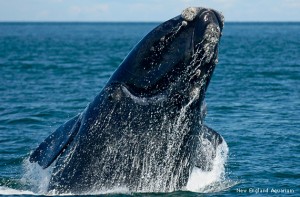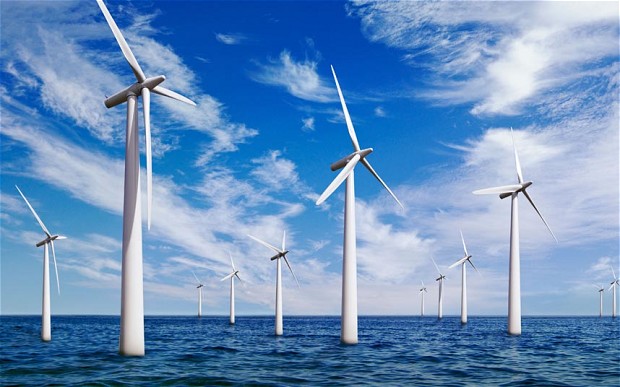A small island is unexpectedly spearheading the push for offshore wind energy. Block Island, RI’s five turbines will begin generating electricity by December as the first offshore wind farm in the nation. Block Island not only demonstrates that offshore wind energy is attainable, but that it can also be built in ways that protects local wildlife. Amber Hewett, who works at the National Wildlife Federation, shares these lessons while proselytizing offshore wind and the protection of New England wildlife.

Amber Hewett, NWF
On a grey-skied New England autumn day I met young and enthusiastic organizer Amber Hewett at a café. She works for the National Wildlife Federation (NWF) on a campaign to promote offshore wind development in New England, New York, and New Jersey through public engagement and communication with state legislators. While some of her coworkers have been pushing for offshore wind energy for over a decade with little progress, Hewett’s four years working on offshore wind development has seen monumental progress. Hewett, a recent graduate from UMass Amherst, explained to me that offshore wind energy is “a beacon of hope” as the “largest untapped energy solution.” And her home state is leading the way.
Last summer Massachusetts Governor Charlie Baker signed an energy bill making a historic commitment to 1,600 MW of offshore wind energy. Just one megawatt of offshore wind energy will power more than 400 homes. This is the first large-scale commitment to offshore wind in the United States, which could jumpstart the industry in the states. Offshore wind as a renewable energy source has many benefits but the memory of Cape Wind in Massachusetts complicates it.
When I asked for a quick defense of Massachusetts offshore wind development, Hewett reeled off five-points with a quick smile. First, the abundance and access of wind resource “cannot be overstated.” Second, the wind offshore blows when electricity demand peaks. Third, the biggest cities are on the coast, which reduces transmission line infrastructure required. Fourth, New England has limited space for solar and wind power onshore. And lastly offshore wind can be built in a “wildlife friendly manner,” a factor especially important for someone who works for the National Wildlife Federation.
A large portion of Hewett’s job is public education, through community forums and writing articles about offshore wind for NWF’s blog. Hewett reported that at public energy forums there is some confusion around the benefits of offshore wind at first. She believes this stems from the confusion and misinformation around the proposed Cape Wind project south of Cape Cod. “Once you capture the scale of opportunity,” she explains, “people usually get to an excited place.” Polls conducted in 2015 reflect this. Over 60% of Massachusetts residents support statewide carbon-free energy and two thirds favor offshore wind for new energy generation.
Massachusetts residents often raise important concerns at the community public forums Hewett holds. A major concern centers on the wildlife impacts of the offshore wind turbines. Here in Massachusetts that concern is primarily focused on the North Atlantic right whale. This whale species is critically endangered, with fewer than 500 individual whales in the North Atlantic. With a steady and determined voice, Hewett affirms that with so few of this whale species “we cannot spare a single one, we cannot compromise on that at all.”
The National Wildlife Federation is a non-profit conservation education and advocacy organization with the mission to seek solutions to environmental issues that work for both wildlife and people. The NWF’s endorsement of offshore wind does not come lightly. Hewett explained to me “as NWF we only endorse projects that we consider to be responsible during all stages of development.” Hewett said that many people are surprised that a wildlife conservation organization endorses an energy source. “We really believe that offshore wind can move forward in a safe way minimizing or avoiding impacts.”
The main risks for North Atlantic right whales occur during the construction phase of offshore wind when collisions with boats and the construction noise pose the greatest threat. The noise from pile driving– drilling turbines into the ocean floor – disrupts their communication, impeding both migration and feeding. Once the turbines are in place, however, they pose no threat to the whales.
Offshore wind can be constructed in a wildlife-friendly manner to minimize such risks. Hewett considers Deepwater Wind’s five-turbine project off of Block Island, RI as a model, praising their voluntary efforts “to go above and beyond requirements.” Deepwater Wind collaborated with the NWF and other environmental law and advocacy organizations to protect these rare whales during construction.
Protective measures included reduced vessel speeds and constant aerial monitoring. Construction would stop if a whale was spotted in the area. Additionally, during peak migration season, specific construction activities were halted. For example, between November 23rd and March 21st, Deepwater Wind did not undertake any drilling. Noise reduction tools and technology were also used to further decrease the impact of construction noise. Hewett emphasized that the NWF believes that Deepwater Wind’s protective measures can be scaled up for large projects, like ones now slated in Massachusetts.
Hewett reminded me that Massachusetts needs energy infrastructure, especially with the Pilgrim Nuclear power plant closing. “Saying no to offshore wind is saying yes to something else,” Hewett explained. 1600 megawatts of offshore wind powering 240,000 homes is on our eastern horizon. This future not only combats climate change but also protects local wildlife.





